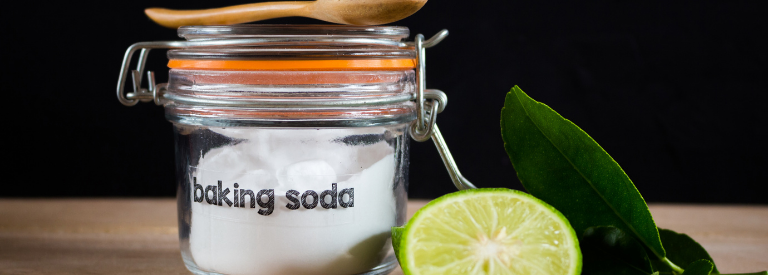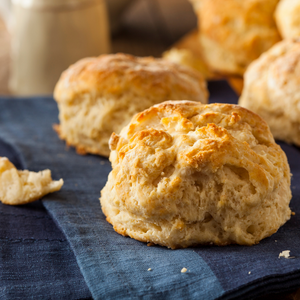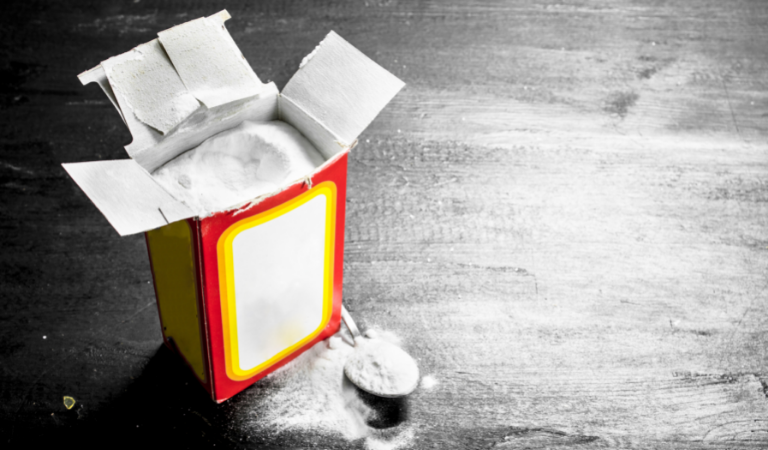If you've ever baked cookies, a cake, or other desserts, you've probably noticed baking soda or baking powder in the recipe. These two ingredients are leaveners, meaning they are what help those baked goods rise in the oven. Without them, your cake would likely come out flat instead of nice and fluffy how you want it. While the two leaveners have a similar color and texture, they are quite different. In this article, we've included everything you need to know about the difference between baking soda and baking powder.
What Is Baking Soda?
Baking soda — also referred to as bicarbonate of soda or sodium
bicarbonate — is a leavening agent used in many baked goods. When baking
soda mixes with an acidic ingredient such as buttermilk, yogurt, or
lemon juice — it causes a chemical reaction and forms carbon dioxide or
CO2. This reaction is what causes cakes or cookies to rise. But, while
this ingredient does help achieve that rise, adding more baking soda
will not cause your dessert to lift more, but instead can alter the
taste of your baked goods.

When To Use Baking Soda
If the recipe includes buttermilk, natural cocoa powder (not dutch processed), lemon juice, or another acid, then it is likely baking powder will also be included. You need the acid in the recipe to combine with the baking soda in order to create CO2. Remember to always use the exact amount of baking soda listed in the recipe. Using too much can lead to a metallic taste while using too little can make your baked goods dense or flat.
What Is Baking Powder?
Baking powder is baking soda combined with cream of tartar, which is a dry acid. Because there is already an acid present, baking powder does not require an additional acid to react. When baking powder combines with a liquid, the reaction occurs and creates CO2. This means that in order to function as a rising agent, baking powder needs a non-acidic liquid.
When To Use Baking Powder
Since baking powder doesn't require an additional acid to react, it is
normally used in recipes that don't call for an acidic component. For
example, a biscuit recipe may opt for baking powder because it doesn't
include acidic ingredients, but may require a liquid such as milk that
can activate the leavener.

Double-Acting Vs. Single-Acting
There are two different types of baking powder: double-acting and single-acting. Double-acting is most likely the kind you buy at your local grocery store, whereas single-acting is more often used by professional bakers.
Double-acting baking powder goes through two rising processes. The first rise is when the baking powder combines with a liquid and the second occurs when the leavener is heated, meaning when it is in the oven. Single-acting baking powder differs because it only rises once when it reaches a high temperature in the oven.
What's The Difference Between Baking Soda And Baking Powder?
The main difference between the two agents is that baking soda is sodium bicarbonate, while baking powder is sodium bicarbonate mixed with a dry acid. Baking soda and baking powder have different chemical compositions and functions. For baking soda to activate, it needs to be combined with an acid. On the other hand, baking soda must be combined with a liquid to react. Because baking soda is pure bicarbonate of soda, it is up to 3-4 times stronger than baking powder.
Can You Substitute One For The Other?
Substituting any ingredient in a recipe can be risky, and it's no different when it comes to baking soda and baking powder. While it is possible to do so, remember that alternating one for the other can yield unexpected results if done incorrectly. Below are some tips on how to substitute baking soda for baking powder (and vice versa) as well as some other replacement suggestions.
Substitute For Baking Soda
To replace baking soda with baking powder, you have to use around 3 times as much for it to be effective. For example, if the recipe calls for 1 teaspoon of baking soda, you can use 3 teaspoons of baking powder.
TIP: Because baking powder already contains baking soda, consider replacing other acidic reactants in the recipe to avoid an overly acidic baked good.
Substitute For Baking Powder
To replace baking powder, you can mix baking soda with cream of tartar; this is almost like creating at-home baking powder. For 1 tablespoon of baking powder, mix 1 teaspoon of baking soda with 2 teaspoons of cream of tartar.
TIP: If a recipe happens to call for both baking soda and baking powder and you don't have either, you can always use self-raising flour instead of all-purpose flour.
Why Do Recipes Call For Both?
In some cases, you may come across a recipe that lists both baking soda and baking powder. For example, buttermilk pancakes often call for both in order to neutralize the acid while maintaining a tangy flavor. There could be a few reasons why you would use both when baking:
- For some recipes, the baking soda will neutralize the acid in the recipe, but won't create enough CO2 to cause a rise. In a case like this, baking powder can be included so you don't have to add more baking soda and alter the taste.
- Baked goods tend to brown and rise better in alkaline environments. Baking soda is sometimes added to recipes where the main leavener is baking powder to provide more alkaline.
- Some goods may call for an acidic ingredient specifically for its flavor, such as lemon juice. When this happens, you don't want the baking soda to completely neutralize that flavor. By having both baking soda and baking powder, it balances out enough with the acid to maintain that tangy flavor while also allowing your dessert to lift.
How To Store Baking Soda And Baking Powder
When it comes to baking soda and baking powder, chances are you bought them years ago and have been keeping them in your cupboard since. We've all been there. But, it's actually pretty important to pay attention to how we're storing our leaveners and how long we're keeping them.
Your baking powder and baking soda should be kept in a cupboard that is far from the stove, dishwasher, or any other point of moisture in your kitchen. This prevents the leaveners from absorbing humidity and potentially causing a reaction. This is especially important for baking soda, since it is often sold in a cardboard box without an airtight seal. To make sure moisture stays out, you can keep your box of baking soda inside of an airtight plastic bag.
When stored properly, baking powder has about a one-year shelf life, and baking soda can last around six months. It's important to check the expiration dates on these products because using old or expired leaveners can lose efficacy and therefore, cause your desserts to come out flat. To test if your baking powder is still good, you can combine a dash of baking powder with a little bit of hot water. If it starts bubbling, then it's still good. To check your baking soda, you can combine some baking soda with a bit of vinegar. If it bubbles as well, then it's good.
TIP: If your baking powder is expired, you can still
use it as baking soda, so there is no need to toss it out!

Baking Soda & Baking Powder Besides Baking
Both baking soda and baking powder can have other uses besides baking. Baking soda is often used for cleaning and scrubbing. You can also leave an open box in the fridge to absorb odors, drink some with a bit of water for an upset stomach, or even use it to brush your teeth. Baking powder can be used to remove grease from clothes, as a soak for pots and pans, to clean your microwave, or unclog a drain.
Time To Bake!
Despite some similarities, baking soda and baking powder are two distinct products. Their chemical makeup, how they interact with other ingredients, and the recipes in which they are used all show the difference between these two leavening agents. Next time you're baking fresh biscuits or some yummy chocolate chip cookies, you'll be prepared with all the knowledge you'll need when it comes to these two ingredients.






